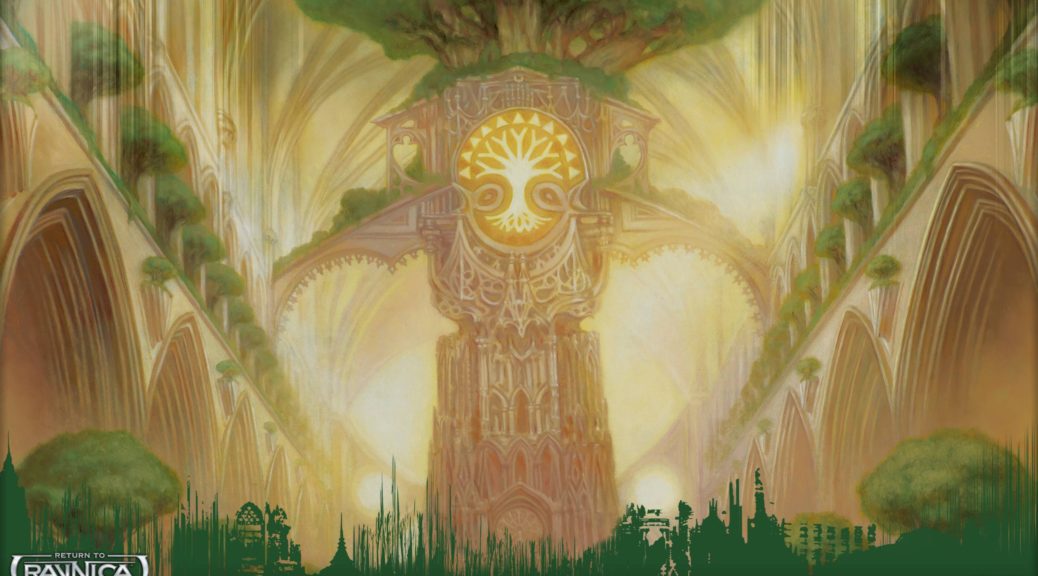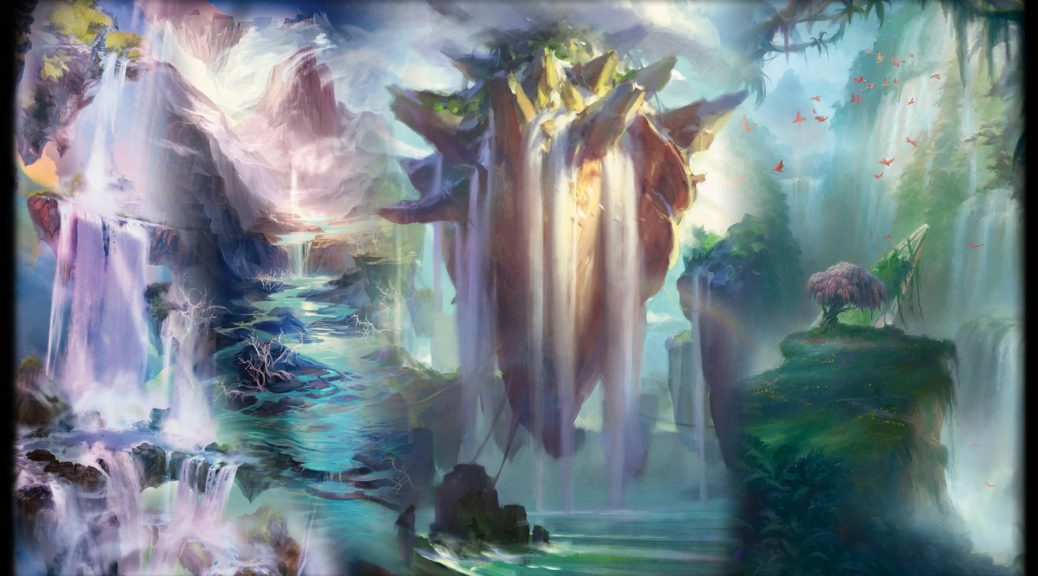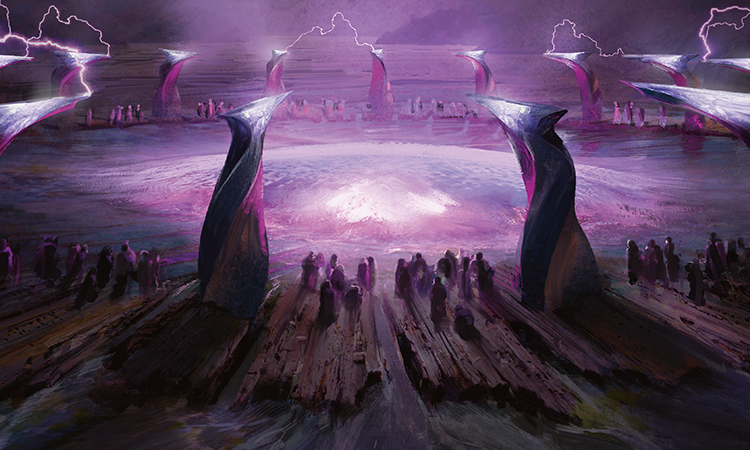By: Travis Allen
@wizardbumpin
Don’t miss this week’s installment of the MTG Fast Finance podcast, an on-topic, no-nonsense tour through the week’s most important changes in the Magic economy.
The rest of this content is only visible to ProTrader members.

ProTrader: Magic doesn’t have to be expensive.
A couple of weeks ago we looked at how Battle for Zendikar prices have fared overall with respect to the Expeditions. This sort of retrospective is useful, as it informs us about how the market responds to changes in typical expansion products. The next time they do an Expeditions run, we’ll know much more about how the set they’re included with will react.
How about the Expeditions themselves, though? Originally released in Battle for Zendikar on October second, it’s now been a little over ten months since the initial run, with the Oath of the Gatewatch cycle coming three months later. This special print run was the first of its kind in more ways than one. The closest we’ve seen to special pack inserts at that distribution level was the original Zendikar “priceless treasures” promotion, which included cards from Magic’s earliest years showing up extremely rarely in packs. We had never seen “luxury” lands quite like this, at least not in this volume. They came with all new art and all new borders. Some of the cards were Standard legal while others weren’t even legal in Modern. Overall, Expeditions as a whole was a theretofore unknown quantity.
Initial expectations were that prices would be wild on these. Alternate art, new-border foils of some of the most played cards across Magic’s domain had to be valuable, especially if their print run was limited. What devout Vintage, Legacy, or Modern player wouldn’t at least consider them? Every writer chimed in, even the non-finance ones, with their expectations of how these would impact Magic as a whole. It didn’t take long before there was activity. Scalding Tarn exploded pretty quickly, and other blue fetches saw rapid movement as well. Expectations were generally that it would be tricky to pin down exactly what the rate of growth would be, but that there would almost definitely be steady growth for a long time. With limited supply and no foreseeable reprints on fancy, highly-desirable constructed cards, what else could happen?
Today we’re here to see how that has panned out. I noticed a couple on my desk the other day and began thinking about how well they have or haven’t done. Several months ago I bought quite a few, and I haven’t bothered to check in on them in awhile. I’m sure I’m not the only one with spare copies set aside, so let’s see how Expeditions are looking almost a year after release.

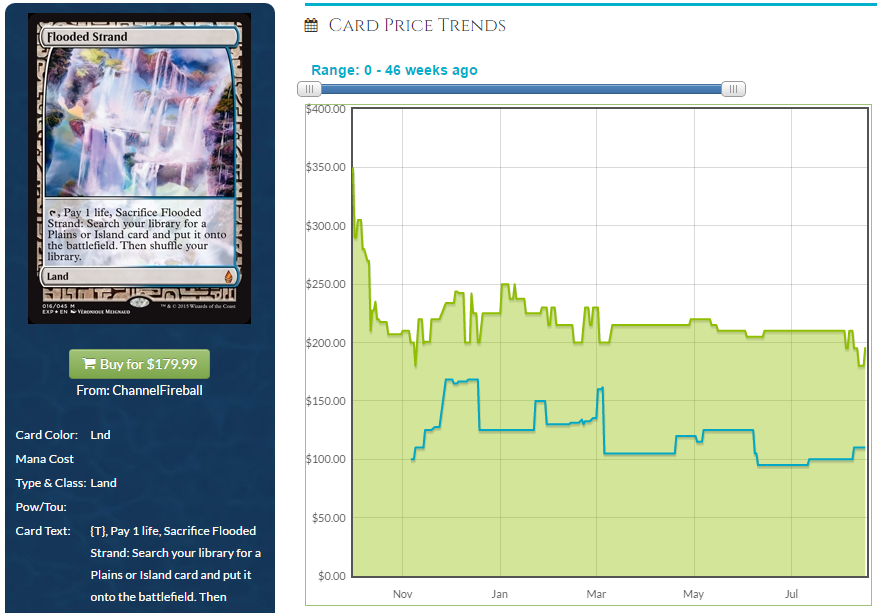


Clearly, things are not all rosy profits.
Looking through price graphs for all the Battle for Zendikar Expeditions (I’m ignoring ones from Oath of the Gatewatch for the time being), there’s a consistent theme among them. Prices were loopy at pre-release, then dipped pretty hard. They climbed to a peak sometime in January, and since then they’ve mostly been losing ground, albeit at a snail’s pace. There’s minor variations on that theme, but overall, it’s a recognizable pattern.
If we extend our purview to the Oath of the Gatewatch copies things don’t change much. Anything that isn’t Ancient Tomb or Eye of Ugin — both lands that were (and still are, in Legacy) part of Eldrazi Winter — remarkably resembles the bunny hill at your local ski slope.
Looking at this data, I find myself with two questions. What the hell happened, and what do I do now?
As for the first — I’m not quite sure. Sussing out causality in a muddled market burdened by the inconclusiveness of reality is always a questionable endeavor at best. Without clear and measurable evidence you’re never really quite sure why things that happen, happen. You’re left with educated guesses and not much more. (And if you’re Hume, that’s all you ever get, period.)
Basically everyone expected these things to begin rising in price within a month or two of hitting shelves. A simple understanding of economics would lead you to that conclusion. You have a good for which 95% of supply will be available within several weeks of its initial release. After that players will slowly acquire their own copies whether via binder grinding, PucaTrading, or purchasing them outright. Slowly but surely less and less copies will be available to the general public. Prices will begin to rise as a result. Seems easy, right? It can be tricky to nail down the scale of time, but the general trend was clear.
Instead, these have lost ground since the beginning of the year for the most part. Why would they do the opposite of the obvious?
One explanation is that they’re still on track to behave as we always planned, except over a much longer time frame than anticipated. Perhaps the period where supply is outpacing demand and prices are falling as a result didn’t take two or three months, but instead is taking upwards of a year or more. These are undoubtedly expensive cards, and it may take time for people to scrounge up enough capital to acquire these. Only after the slack in the market gets picked up will supply begin to see constraint and subsequent rises in price. If this is the case, then we would expect to see an inflection point eventually, and then the climb back up. At the very tail end of some of the shocks you can see an upturn. Is that a wrinkle or the start of a trend? It’s impossible to say at this point.
Perhaps instead it’s not a time frame issue, but one of incorrectly assigned demand? Prices may have been as high as they were early on because everyone thought everyone else wanted copies, but it turns out nobody actually wanted them. Upon examination, they’re truthfully not the greatest looking. They’re dark, trend towards warping, and the foiling process isn’t ideal. Even though the frames and art are selling points, once they were in people’s hands, the general consensus was “oh, these aren’t as cool as I thought.” As a result perhaps there’s considerably less demand in the population for these, and we’re just watching the prices fall until they finally meet people’s revised opinions.
Another perspective is that it’s just been a mediocre eight months for flashy manabases. Here’s the chart for a few Return to Ravnica block foil shocks.

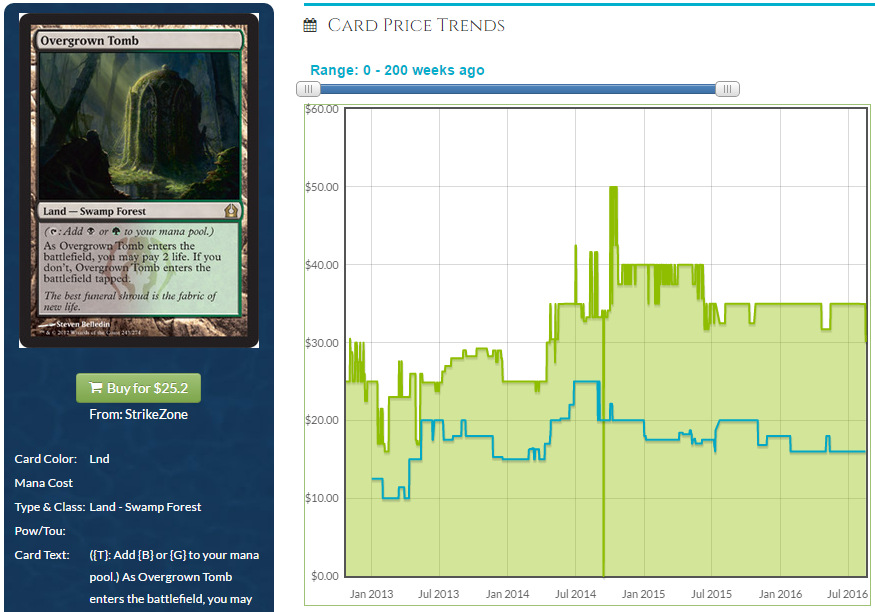
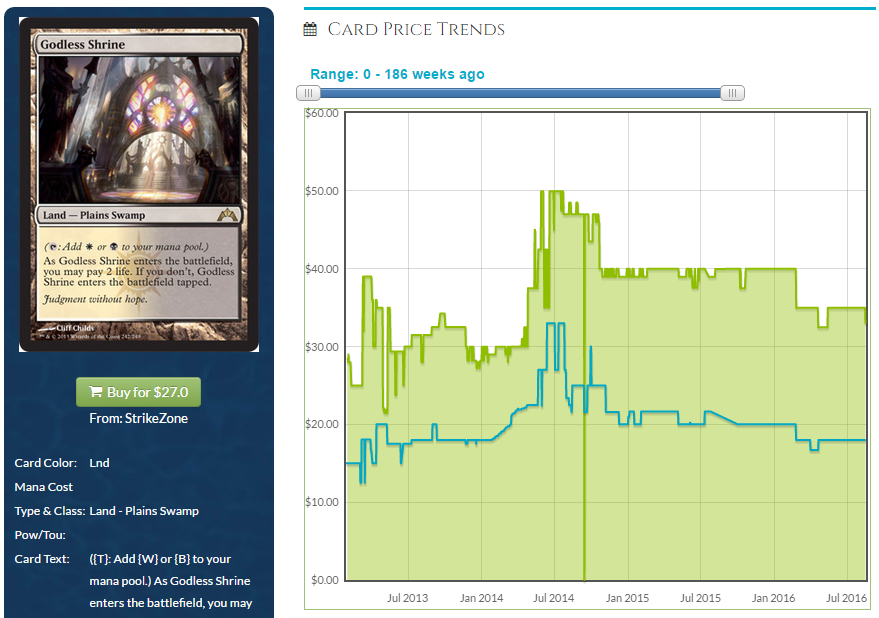
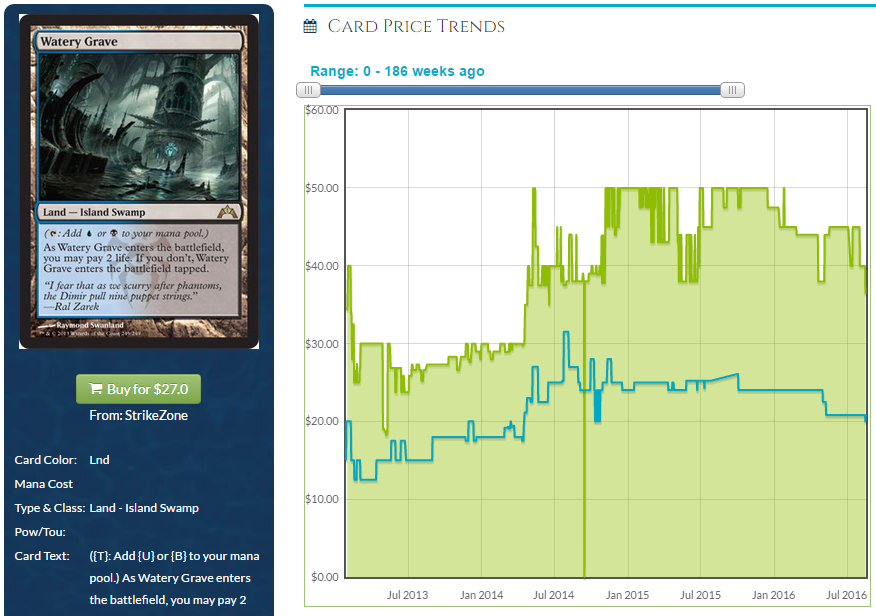
Looking at these graphs, with the exception of Steam Vents perhaps, I find the word “malaise” on my fingers. Foil RTR shocks have been around a lot longer than Expeditions; certainly enough to burn through excess supply. Why then would prices be softening on these as well? This would indicate it’s not just a matter of Expeditions trying to work through the initial onslaught of supply. Interestingly, the original Zendikar foil fetches have fared a bit better. Only Marsh Flats looks worse today than it did around BFZ’s release.
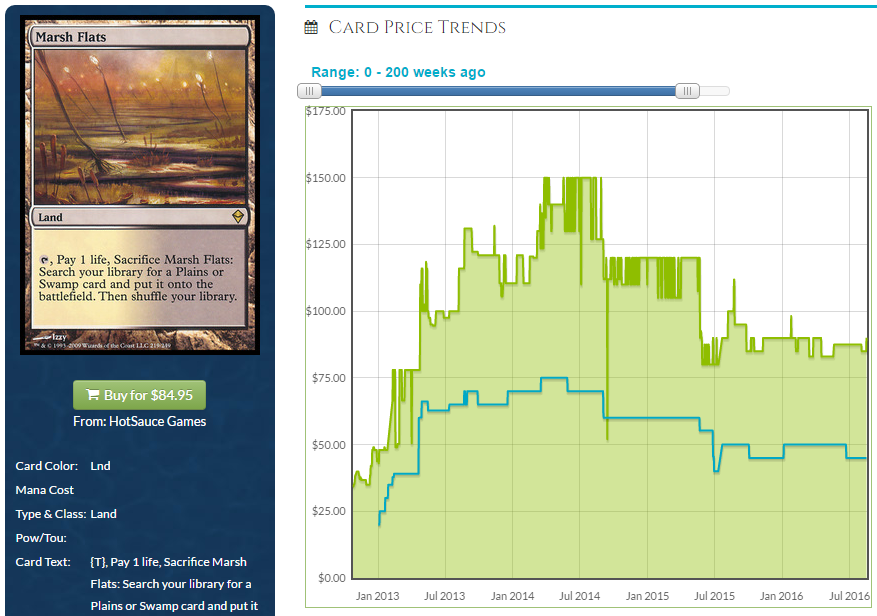
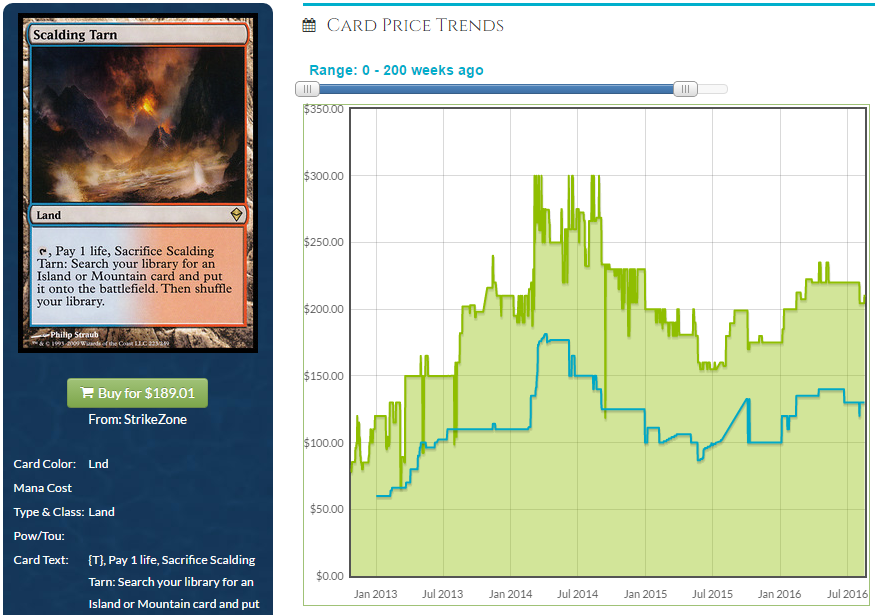
My suspicion is that this has to do with our understanding that the overall playerbase of Magic is shrinking, or at least growing far less quickly. Evidence of this is found in Magic’s product release schedule changes over the last year and a half or so. Standard seasons have been shortened, requiring players to purchase more cards to keep up, and the product release schedule is blazingly fast these days between expansion sets, summer multiplayer set, clash packs, commander decks, limited release products, and more. If you’ve got fewer total players buying cards, increase the number of cards each player needs to buy.
If it’s true that this is related to playerbase shifts, it still makes sense that cards from the Zendikar era can rise in price while cards from RTR and forward just can’t keep it up. Return to Ravnica was the tipping point where they cranked print runs to 11, and since then, there has seemingly been far more supply relative to the player base than years prior. As a consequence of that, it may be that luxury (as if that somehow differentiates one Magic card from another) cards from newer sets aren’t going to have the staying power that older ones do. Now even if we went into BFZ with this as a clear concept we wouldn’t necessarily think Expeditions would be as vulnerable to this, given the limited run. And yet, here we are.
We could probably sit around and philosophize about the flaccidity of foil mana bases for awhile. We’ll never have an exact answer though, and we’ve got to decide what to do before this article ends.
This is not an easy call. In one universe, I hold onto the Expeditions with the expectation that they begin rising. Instead they continue to falter, and rather than having cut my losses, I end up even deeper underwater. In another universe, I sell them now so as not to get gotten by the gambler’s fallacy, and by this time next year they’re up 30%. How do we avoid getting nailed by both of these?
I went looking for more data points to try and better educate myself on what the right strategy is. What has happened with other cards in the same general vein? I started with FTV sets. Those are limited run reprints that always contain a handful of constructed relevant cards. They’re not exactly the chasiest of chase cards, as the FTV foiling is heinous and a detriment to the product rather than a boon, but the Expeditions foiling isn’t superb either.
FTV: Realms
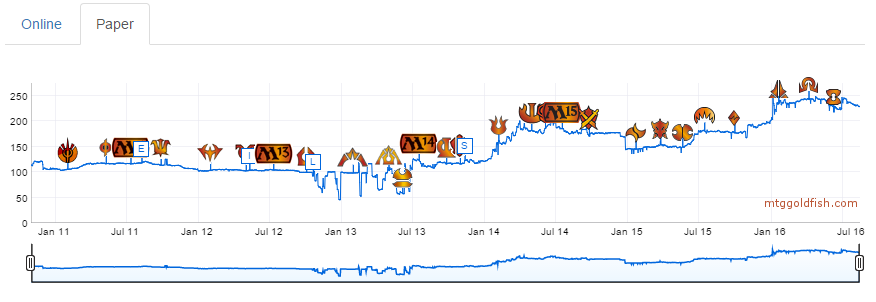
FTV: Twenty
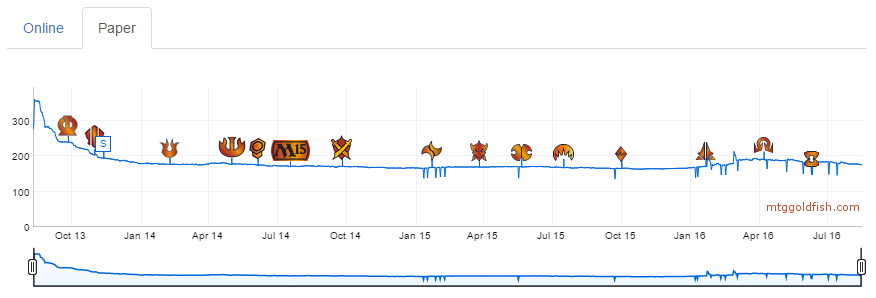
FTV: Legends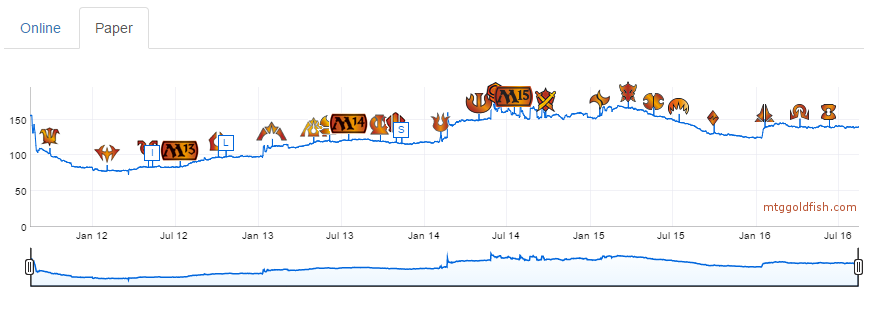
Basically across the board FTV sets have been flat lining for years or falling. There’s almost no impressive growth from them as an entire category. In a few places we see growth — FTV Realms, most notably — but that was almost assuredly because the cards inside became more desirable from a constructed standpoint.
I also checked in on judge promos. Gaea’s Cradle, the most expensive promo to date, was flat, saw a huge spike in response to the legend rule change, and then is flat. Elesh Norn, Grand Cenobite: flat. Lightning Bolt: flat, spike, flat. Imperial Recruiter: flat, spike, flat. Last year’s Wasteland: steady decline. Karakas: A year of growth, followed by a year of loss. Sneak Attack: flat, spike, steady decline. Gemstone Mine: steady growth.
Evidence on the judge side of things is less clear. Most are worth more now than they were in the past, though their path to get there is not consistent nor inspiring. Many go long periods of time with no action at all, and then spike suddenly, whether because of a rules change or just the whims of the market. After this spike they mostly plateau again. Others, though fewer, trend up or down. Overall they’re a mixed bag, generally marked by an increase in value, not reliable or predictable. As a whole they’re partially inspiring, since large spikes that you can’t see coming appear par for the course, which would mean that my Bloodstained Mires may be $180 one morning after months of no activity. It’s only partial though. I could be waiting years, and who’s to say it will ever actually happen?
It’s been several days since I started writing this article, and as I send it to publication Tuesday evening, I find myself wringing my hands over the conclusion. I’m underwater on the seven Bloodstained Mires I bought, but I’m in the black on the Wooded Foothills at enough to basically break even across the board. The Temple Gardens and one or two other assorted ones I have are all in the black as well, though once you subtract fees and shipping, only by pocket change. This isn’t an article where I can just pick a direction and throw it out there without really caring if it’s right or not. (Not that I do that anyways.) I’ve got a lot of personal money wrapped up in this, and making the right decision is important.
At first I was thinking about selling the ones I’m positive on and holding the ones I’m behind on, with the thought process that I’ll take the profits where I’ve found them and hope things get better where I haven’t. I find that the profits are so marginal though, and the losses on the Mires shallow enough that neither of those is compelling in either direction. Selling everything is just about break even, and probably the safest play overall, though it’s tough to shake the feeling that I’m leaving a lot of money on the table, especially when going back and reading my original article on the purchase shows several intelligent peers all recommending these as investments. I do have to admit though, those foil shock charts are scary. Why are those losing value over such a long period of time? With Modern’s growth over the last two or three years, shouldn’t they be rising instead?
I suppose I’m landing on holding for the time being. It’s the default option for now, as it’s what happens if I take no action. I have to think — hope, I think is probably more accurate — that things turn around later this year or early next year. Even if it’s taking longer to burn through excess supply, they’re still distinct and some of the most playable cards in every format of Magic aside from draft and Standard, and even not necessarily on the latter. It’s a small comfort that prices aren’t dropping precipitously, so if at any point we decide that it’s better to move funds elsewhere, they shouldn’t be too much cheaper than they are today. And all the while we maintain the possibility of doubling up on these, and if judge promos are any indication, practically overnight.
After this article is live I’ll be quite curious to see what others chime in with. I don’t think I’ve ever finished an article with so soft a conclusion. Sometimes there’s no obvious answer.

